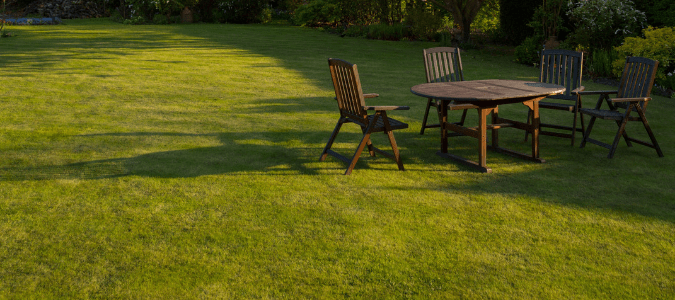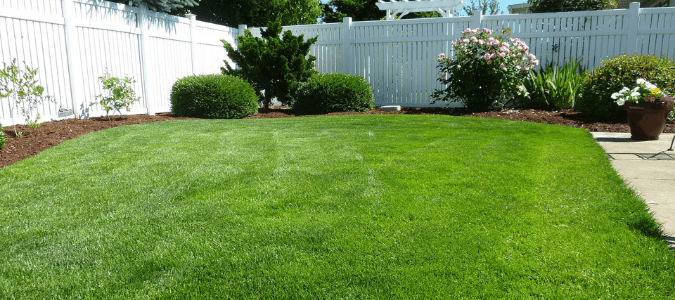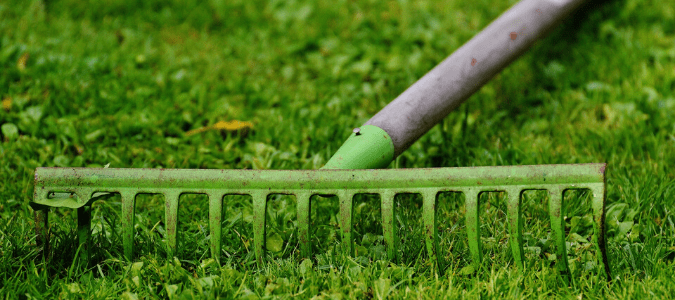When we look out at our yards, we want to see a healthy, green carpet of grass. Bumps, dips and other irregularities in the lawn that create an uneven appearance isn’t very attractive. But, that’s not the only problem. They’re also much harder to mow than flat lawns. And, most importantly, they are a potential hazard for anyone who might trip over the uneven spots as they walk or run across the yard. This is why it’s good to know how to fix a bumpy lawn. You’ll make your lawn look more beautiful while also making it easier to mow and maintain. And, you’ll actually be making it safer for anyone spending time in your yard.
To address an uneven lawn, it’s helpful to know how these bumps develop in the first place. Typically, this happens over time, as the grass first becomes established and then thins out through seasonal weather changes. The earth swells with the heat of summer and contracts with the cold in winter. These changes happen even more quickly if the grass isn’t watered, fertilized and aerated on a regular basis. Over time, the repeated shifting and breaking down of the soil creates higher and lower spots.
Dips and bumps can also come from landscaping changes, such as when you remove trees or bushes. Or, bumps can come from animals digging in the soil. Even earthworms can create tiny bumps in a lawn, since they make mounds of dirt wherever they are most active. Worms are great for soil, and lots of worm activity is a sign of a healthy yard. But, these protrusions may be something you decide you need to get rid of. Whatever factors have caused the bumps in your yard, those low spots can be raised and smoothed out. This will make your lawn safer, easier to maintain and more beautiful.
So that brings us back to our original question: how do you fix a bumpy lawn? One quick, drastic and expensive way would be to replant the entire lawn with new sod, but that shouldn’t be necessary. There are other, less invasive approaches that also work. One is to dig out the grass covering a lower spot, add soil to raise the level of the small area and then either spread grass seed or plant a few rectangles of new sod. This is a good way to treat just a few low spots in your yard.
An even better way to fix a bumpy lawn takes more time and also is more of a preventive measure. Each year, add a layer of top dressing to the entire lawn to enrich the soil. If you have a warm-season grass in your yard, such as St. Augustine or bermuda grass, top dressing should be done in the spring, as temperatures get warmer. If your lawn is a cool-season grass, such as ryegrass or Kentucky bluegrass, top dressing can be done in the fall.
Adding top dressing encourages the grass to grow more thickly, which is the best way to keep bumps from developing in the first place. For top dressing, some people like to use compost or topsoil, while others prefer a mixture of the two. You can also mix either soil or compost with some sand, if the soil of your yard has a high clay content. Whichever type of top dressing you choose, you can add a quarter-inch layer to the entire yard. Just be sure to add a bit more in the lower spots to build up those areas.
Before adding top dressing, you should first aerate the lawn. This way the top dressing can fill in the holes that are created during aeration. This will build up the grass even more quickly. Just be sure not to add too much top dressing, since this could bury the grass and make your lawn more vulnerable to drought and heat.
Many people have trouble staying on top of aerating their lawns and adding fertilizer or top dressing at the right times of year. While this one task sounds very simple by itself, there’s also the regular keeping up with watering, mowing, edging and other lawn maintenance needs. Thick grass adds to curb appeal and quality of life, but it requires some regular maintenance and know-how. Hiring a lawn care specialist to take care of every aspect of maintaining a healthy yard takes both the guesswork and the labor off your plate. This way, you can simply enjoy your outdoor living space.
Another method of fixing bumps in your lawn is to roll your lawn. However, there are things you should keep in mind if you do decide to go this route.
When To Roll Your Lawn
If you have a bumpy lawn, smoothing out the dips and humps will make your yard level and smooth. Rolling your lawn can be a useful way to flatten out bumps, but you need to know when to roll your lawn for the best results. It’s also important to know how to do it in a way that won’t harm the grass, soil, worms or any other beneficial insects.
What is rolling the lawn, anyway? It’s actually just what it sounds like. You use a large, heavy, cylindrical roller to roll across the grass to flatten it. Lawn care professionals might use lawn rollers that are attached to large, wheeled vehicles. You can buy or rent a manual version from your local gardening and home improvement store.
Whether they’re manual or mechanical, lawn rollers are big and heavy, which makes them tough for many people to use or manage. Also, use of lawn rollers is controversial. Some people with bumpy lawns swear by them. But, others make the point that lawn rollers can damage grass by crushing it and compacting the soil. Rollers can also harm worms and other beneficial insects that live in the grass.
If you choose to roll your lawn, keep in mind that it’s not something that should be done very often. Many aspects of lawn maintenance should be done once a year, once a month or even weekly. Rolling your lawn, on the other hand, should be done only when needed, and less than yearly. If your lawn is so uneven that it seems to need annual rolling, a different approach is needed. If this is a recurring issue for your yard, preventing bumps in the first place with regular care and maintenance should be your priority.
If you do roll your lawn, it’s not a good idea to do it when the ground is wet. This technique works best if you do it when the soil is damp. If the ground is too wet, rolling it could create trenches and make the uneven grade even worse. It’s also not a good idea to roll the lawn in late summer or early fall, when the grass is fully within its growing phase. If you’re going to roll the lawn, do it in early spring, when the grass is starting to emerge from its dormant phase.
It’s also important to use the right size and weight of roller. If you use a roller that is too heavy, it’s sure to cause problems. You can damage your grass and its roots, compact the soil, create low spots in the lawn and crush beneficial insects living in the soil. Compacted soil is one of the major causes of a bumpy lawn. So, if using a roller compacts it even further, you might as well not use the roller at all.
Many gardeners and landscapers believe rollers do more harm than good and should never be used. Whether you’re a fan of rolling your lawn or not, it’s certainly true that regular lawn care and maintenance are the best way to keep your lawn smooth and even. If bumps develop despite regular care, you can “spot treat” them by replacing patches of grass with extra soil and new sod.
Hiring a lawn care professional is also a good idea whether you’re dealing with existing bumps or trying to prevent them in the future. Professionals can manage details like fertilizing, aerating and applying top dressing. You can also rely on a trusted provider to keep up with a regular mowing schedule for you. This will take these duties off your plate so you can enjoy a healthy lawn without the work and headache of keeping it that way.
Another important aspect of lawn care is dethatching your lawn. However, like rolling, there are pros and cons associated with this lawn care task.
Pros and Cons of Dethatching Lawns
As you decide on a lawn care maintenance program, there are several things to consider when deciding if you need to dethatch your lawn. Thatch is the layer of grass and plant matter that is above the soil, but below the green, living grass. Thatch is a mixture of dead grass blades and living growth, and a thin layer of it is good for the grass. Up to about a half-inch of thatch is helpful to your lawn because it acts like mulch. It protects the grass’s roots from temperature extremes and keeps in moisture during dry periods.
But, thatch can get thick and matted over time. When thatch is too thick, it prevents light, air, water and nutrients from reaching the roots and soil. Overly thick thatch can also trap water when it rains, which can make the grass rot at the roots. All of this can lead to brown or yellow spots in your grass and other issues.
So, the benefit of dethatching is that it can make sure that your lawn is getting the nutrients it needs. But, the downside of dethatching is that, if you pull too much, your grass won’t have protection against heat or drought. Dethatching your lawn is good to do when there is more than a one-inch layer of thatch. If the thatch is more than two inches thick, you might think about contacting a lawn care specialist to do the job for you, to save yourself a good deal of labor.
If you do the job yourself, you can rent or buy a dethatching rake from a hardware store. There are manual and electric versions. You should dethatch as part of your landscaping spring cleanup for warm season grasses, or fall for cool season varieties. It should never be done in the winter, since dethatching during the grass’s dormant phase can damage it beyond repair. To avoid thick thatch in the first place, be sure not to fertilize too often, and don’t mow your grass too short or too often. Dethatching and aeration can work together to create a healthy lawn. But, these practices work most effectively if they’re done correctly and during the right season. Lawn care specialists know the best times and techniques for both of these processes. Better yet, these experienced professionals can take care of all your lawn’s needs throughout the year.
ABC Can Fix Your Bumpy Lawn
As you now know, it takes quite a bit of labor to fix bumpy lawns and prevent bumps from coming back. If you aren’t sure you are up for all that hard work, contact ABC Home & Commercial Services. Our lawn care team has the training and tools to flatten out your lawn. We can also come up with a lawn care schedule so your yard will continue to be healthy and have that flat, green carpet we all are hoping for.



